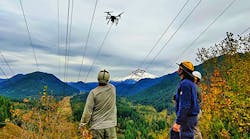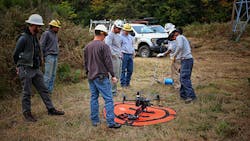On a windy, overcast day deep within the Mount Hood National Forest, the center of three high-voltage transmission tower spans fell silent. It was de-energized for upgrades and maintenance work, and the clock was ticking to have the hum of hundreds of thousands of volts flowing again. The buzz of a small quadcopter drone whirred past; fighting the wind and the weight of rope attached to its belly by a remotely operated clip. A BPA pilot guided it between the transmission tower spans.
This was BPA’s maiden operational flight of a quadcopter or SUAS (small unmanned aerial system), used to pull a line of rope between towers; and in doing so provided significant benefits to safety and cost-efficiency for transmission line maintenance.
These quadcopters are often referred to as drones. Using the drone, BPA crews replaced a fiber optic cable that runs parallel to a high-voltage transmission line that spans the rugged terrain of Lolo Pass. Fiber optics provide critical communications for the operation of the power grid. This particular line had a history of breakage because of heavy ice in the winter and needed to be replaced.
But replacing the cable proved challenging. The standard practice is to use a helicopter to pull a thin rope, or sock line, through a pulley system attached to a transmission tower. The cable itself is then pulled through the pulley system. It is an expensive, time-consuming process. When a helicopter is not available, a lineworker can ride in a cart suspended from the transmission line and slowly traverse the span while pulling the sock line along. Depending on the location and terrain, another option is to have a crew walk the rope from tower to tower while protecting it from being damaged by the ground. The standard alternatives are slow, risky and at times costly.
In this case, the helicopter was not an option. First, the existing fiber optic line could not be taken out of service, and the new line had to be pulled through the lower “armpit” of the double-circuit tower — a needle that would have been nearly impossible to thread with a helicopter.
And, as Mathew Clay from Aircraft Services explained, “This is a center double-circuit span. Flying a sock line with a helicopter is very difficult with live wires on both sides of the tower.”
That is when Lineman Foreman Troy Anderson and Peter Renggli from Aircraft Services saw an opportunity to put BPA’s newly implemented drone program to use.
Renggli and Anderson kept safety the number one priority by researching and testing the drone idea first. They started with one of BPA’s small quadcopters and conducted multiple test pulls in controlled environments to determine the drone’s handling characteristics and performance while pulling a rope.
Once they developed confidence that the drone and its pilot could perform the work successfully, they headed into the field. They surveyed the area and chose the shortest span of transmission line for their first attempt. The crew set up the quadcopter on a portable landing pad and attached one end of the sock line to the bottom of the drone with a carabineer. One crew member held the spool of sock line as the drone pilot and spotters ensured a safe takeoff. The pilot maneuvered the drone toward another crew member waiting at the other end of the span. Halfway across, the wind picked up and gusts started buffeting the small drone. The team had to abort. They regrouped and changed tactics.
The second launch was a success. With each subsequent test run, the team learned more, which improved their procedures and efficiencies. Soon it took longer to set up the drone than it did to pull the line across the spans.
By using the drone, BPA was able to keep both transmission and fiber optic line outages to a minimum. The drone swiftly traversed the span, keeping the rope from being damaged by trees and brush. It saved a significant amount of crew hours, which translated into cost-savings across the agency. It also kept BPA’s crews and pilots out of harm's way, while making the agency’s manned aircraft available for other high priority missions within its service territory.
From time to time, lineworkers will still need to manually pull ropes while hacking through brush on foot. They will still occasionally need to set up and use traveling ladders or conductor carts, and helicopters will still be the go-to option for large projects, as the drones do not have the power or range to pull heavier conductor. But on this otherwise humdrum, overcast day, one field crew added yet another tool to get the job done safely and quickly, laying another stone in BPA's continuous path toward greater cost-efficiency and modernization.



